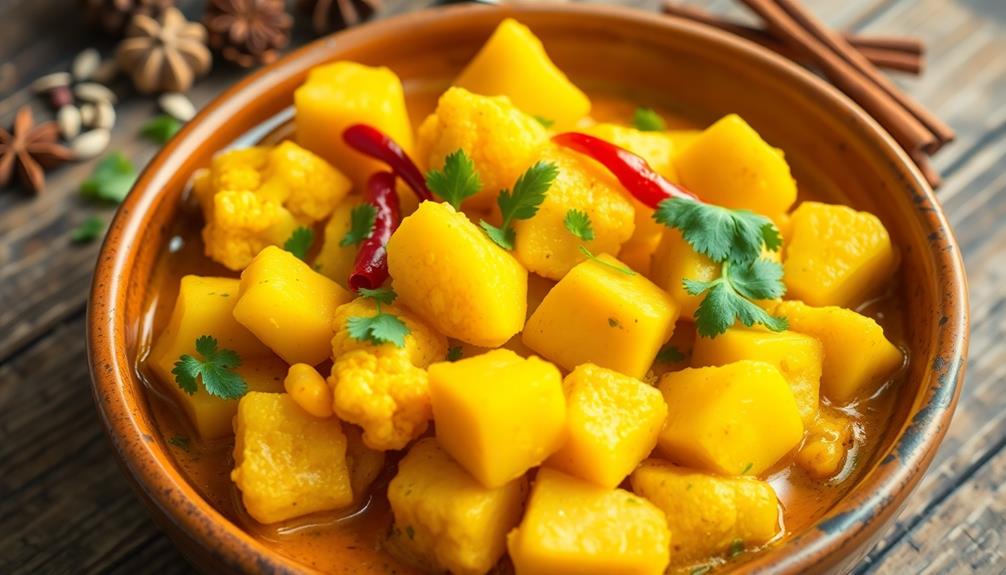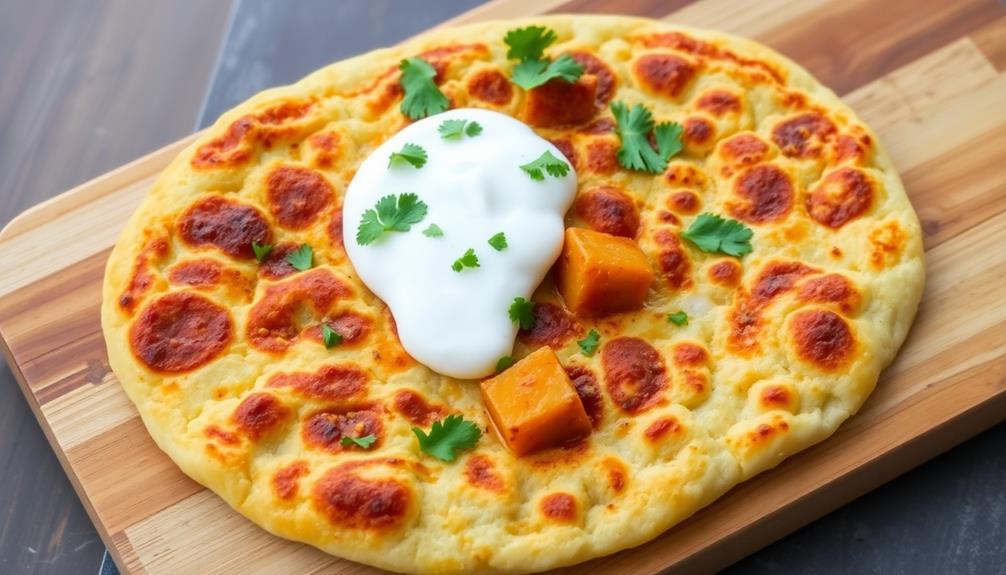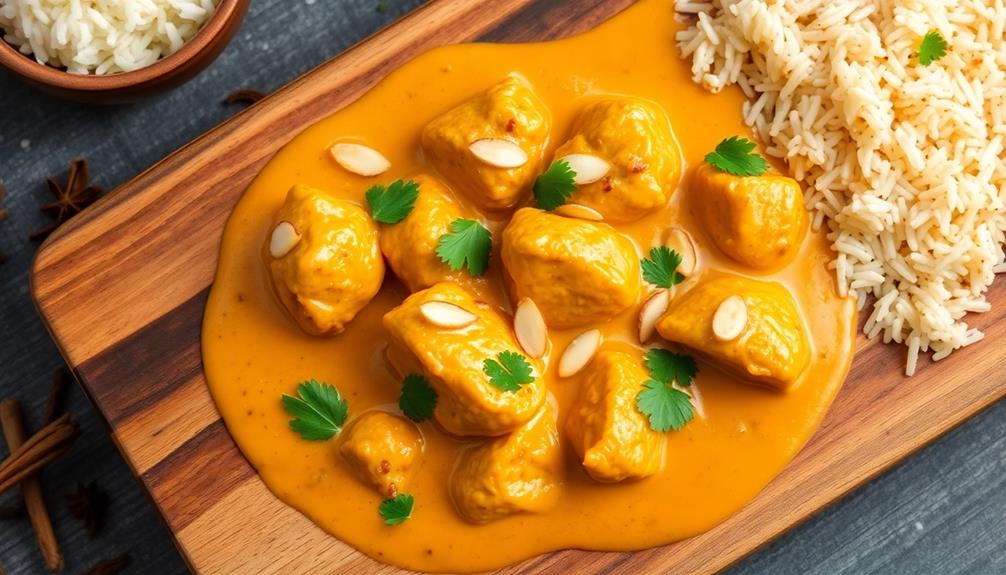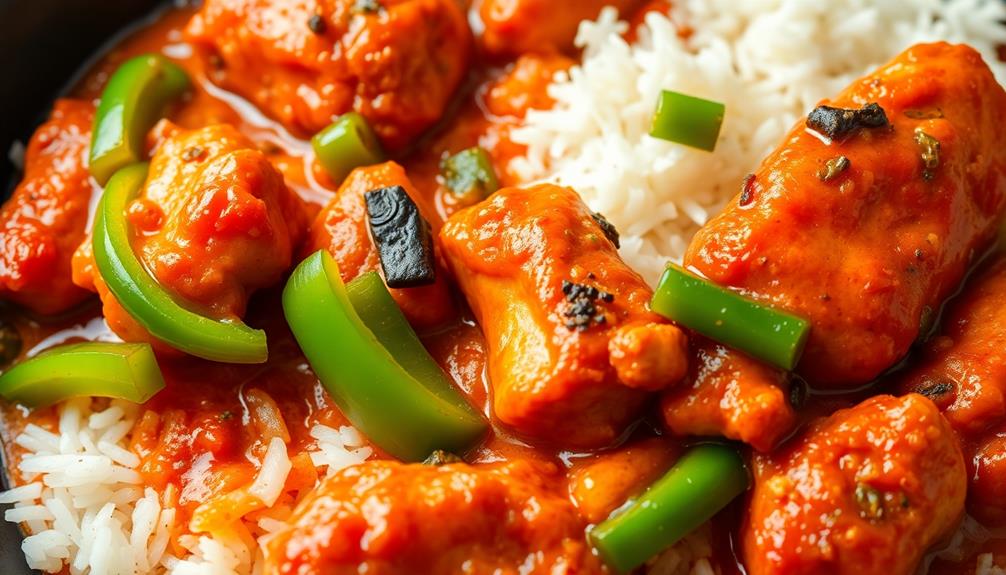Tandoori chicken is a mouthwatering Indian dish you'll love to make at home. It's known for its vibrant red color and smoky flavor. You'll marinate chicken pieces in a mix of yogurt and spices like ginger, garlic, and garam masala. This marinade tenderizes the meat and infuses it with delicious flavors. Traditionally cooked in a clay oven called a tandoor, you can easily adapt it for your regular oven. The result? Juicy, spiced chicken with a crispy, charred exterior. Serve it with sliced onions, lemon wedges, and mint chutney for a real treat. There's so much more to discover about this tasty dish.
Key Takeaways
- Tandoori chicken is a popular Indian dish marinated in yogurt and spices, then cooked in a tandoor oven.
- The marinade typically includes yogurt, ginger, garlic, and spices like garam masala, paprika, and turmeric.
- Originated in the 1940s in Peshawar, Pakistan, and quickly gained popularity throughout India and globally.
- Can be adapted for conventional ovens, with high cooking temperatures essential for achieving a crispy, charred exterior.
- Marination for at least 4 hours or overnight is recommended for best flavor infusion and tenderness.
History
Tandoori chicken's history is as rich and flavorful as the dish itself. You'll be fascinated to learn that this popular Indian cuisine has roots dating back to the 1940s. It all started in Peshawar, which is now part of Pakistan. A man named Kundan Lal Gujral owned a restaurant called Moti Mahal, and he's credited with inventing this mouthwatering dish. Gujral’s ingenious idea to marinate the chicken in yogurt, aromatic spices, and herbs before cooking it in a tandoor oven quickly gained popularity. The dish was a hit with locals, and eventually, Gujral brought it to Delhi where it continued to grow in popularity. In fact, it is said that the creamy and flavorful tandoori chicken became the basis for the recipe for chicken tikka masala, a beloved Indian dish around the world.
You might wonder how he came up with the idea. Well, Gujral was looking for a way to prevent his chicken from drying out in the tandoor, a traditional clay oven. He decided to marinate the chicken in yogurt and spices before cooking it. This brilliant technique kept the meat juicy and tender, while the high heat of the tandoor gave it a delicious smoky flavor.
The dish quickly gained popularity, and soon, it spread throughout India and beyond. Today, you'll find tandoori chicken in restaurants all over the world. It's become a symbol of Indian cuisine and a favorite among food lovers everywhere.
Next time you enjoy this tasty dish, remember its humble beginnings in a small restaurant in Peshawar.
Recipe
Tandoori chicken is a classic Indian dish known for its vibrant red color and bold, smoky flavor. This recipe combines a blend of aromatic spices with yogurt to create a tender and flavorful marinade that infuses the chicken with rich taste and helps keep it moist during cooking.
Traditionally, tandoori chicken is cooked in a tandoor, a cylindrical clay oven that reaches extremely high temperatures. However, this recipe adapts the cooking method for a conventional oven, allowing you to recreate the authentic flavors of tandoori chicken at home. The result is juicy, perfectly spiced chicken with a slightly charred exterior that captures the essence of this beloved Indian dish.
- 2 lbs chicken pieces (preferably bone-in, skin-on)
- 1 cup plain yogurt
- 2 tbsp lemon juice
- 2 tsp ginger paste
- 2 tsp garlic paste
- 2 tsp garam masala
- 2 tsp paprika
- 1 tsp turmeric
- 1 tsp cumin powder
- 1 tsp coriander powder
- 1 tsp red chili powder
- Salt to taste
- Red food coloring (optional)
In a large bowl, mix yogurt with all the spices, lemon juice, ginger, and garlic paste to create the marinade. Add chicken pieces and coat thoroughly. Let marinate for at least 4 hours or overnight in the refrigerator.
Preheat oven to 425°F (220°C). Remove chicken from marinade and place on a baking sheet lined with parchment paper. Bake for 30-35 minutes, turning once halfway through, until chicken is cooked through and slightly charred on the edges. For a more authentic tandoor-like finish, broil for the last 2-3 minutes to create a crispy exterior.
For best results, use bone-in chicken pieces as they tend to remain juicier during cooking. If using boneless chicken, reduce cooking time to prevent drying out.
To achieve the signature red color without food coloring, increase the amount of paprika or add a small amount of beetroot juice to the marinade. Serving the tandoori chicken with sliced onions, lemon wedges, and mint chutney enhances the overall dining experience and adds a refreshing contrast to the rich, spicy flavors of the dish.
Cooking Steps
Get ready to create mouth-watering tandoori chicken with these simple steps!
You'll start by marinating the chicken in a flavorful yogurt mixture, then preheat your tandoor or oven for cooking.
Once everything's set, you'll skewer the marinated chicken pieces and cook them until they're beautifully golden brown, finishing with a sprinkle of fresh herbs for that perfect touch.
Step 1. Marinate Chicken in Yogurt Mixture

To kick off the marination process, you'll need to prepare the yogurt mixture. In a large bowl, combine plain yogurt with a blend of aromatic spices. You'll want to add ginger, garlic, cumin, coriander, turmeric, and garam masala. Don't forget a squeeze of fresh lemon juice for a tangy kick! Mix these ingredients well until you've got a smooth, fragrant paste.
Now, it's time to get your hands dirty! Take your chicken pieces and make small cuts on the surface. This'll help the marinade seep in better. Then, gently massage the yogurt mixture all over the chicken, making sure to coat every nook and cranny.
Once you're done, pop the marinated chicken into a covered container or zip-lock bag.
Here comes the waiting game! Let your chicken rest in the fridge for at least 4 hours, but overnight is even better. This'll give the flavors plenty of time to work their magic.
When you're ready to cook, take the chicken out and let it come to room temperature before you start grilling. Your taste buds will thank you for the patience!
Step 2. Preheat Tandoor or Oven

Now that your chicken has marinated to perfection, it's time to fire up your cooking apparatus. If you're lucky enough to have a tandoor, you'll want to heat it to about 900°F (480°C).
Don't worry if you don't have one, though! Your regular oven will work just fine for this delicious dish.
For oven cooking, preheat it to 450°F (230°C). This high temperature will help create that crispy, charred exterior that tandoori chicken is famous for.
While your oven is heating up, place a baking sheet or roasting pan on the middle rack. This will get nice and hot, giving your chicken a good sear when you put it in.
If you're using a grill, set it to high heat and close the lid. Let it get really hot before you add the chicken.
This method will give you those beautiful grill marks and that smoky flavor everyone loves.
Step 3. Skewer Marinated Chicken Pieces

Skewering the marinated chicken pieces is a crucial step in preparing authentic tandoori chicken. You'll want to grab your metal skewers and get ready for some fun!
First, take each piece of chicken and carefully thread it onto the skewer. Don't pack them too tightly – leave a little space between each piece so the heat can circulate evenly.
As you're skewering, make sure to push the chicken pieces towards the middle of the skewer. This'll help prevent them from sliding off during cooking. If you're using wooden skewers, remember to soak them in water for about 30 minutes before use to prevent burning.
For larger pieces like chicken legs or thighs, you might want to use two skewers parallel to each other. This'll give you better control when turning the chicken on the grill or in the tandoor.
Once you've skewered all your chicken pieces, give them a final brush with any leftover marinade. This'll help keep the chicken moist and flavorful during cooking.
Now you're all set to move on to the next exciting step in your tandoori chicken adventure!
Step 4. Cook Until Golden Brown

With the skewers in hand, you're ready to cook your tandoori chicken to golden-brown perfection.
Preheat your oven to 425°F (218°C) and place the skewers on a baking sheet lined with foil. Make sure there's space between each skewer so the heat can circulate evenly.
Slide the baking sheet into the oven and let the magic happen! You'll want to cook the chicken for about 20-25 minutes, turning the skewers halfway through.
As it cooks, you'll notice the chicken taking on a beautiful golden-brown color. That's when you know it's getting close!
To check if it's done, look for a few signs. The chicken should be firm to the touch, and when you cut into the thickest part, the juices should run clear.
If you have a meat thermometer, the internal temperature should reach 165°F (74°C).
Once your tandoori chicken is cooked to perfection, carefully remove it from the oven.
Let it rest for a few minutes before serving. This resting time allows the juices to redistribute, making your chicken even more delicious and tender.
Step 5. Garnish With Fresh Herbs

A final flourish awaits your perfectly cooked tandoori chicken. It's time to add a burst of freshness and color to your dish with some aromatic herbs. You'll want to choose herbs that complement the rich, spicy flavors of the tandoori seasoning.
First, gather a handful of fresh cilantro. Rinse it thoroughly under cool water and pat it dry with a clean kitchen towel. Carefully pluck the leaves from the stems, discarding any that look wilted or discolored.
Next, grab a few sprigs of fresh mint. Give them the same treatment as the cilantro. These two herbs will work together to create a bright, zesty contrast to the smoky tandoori flavors.
Chop the herbs finely or leave them whole, depending on your preference. Sprinkle them generously over your tandoori chicken just before serving. The vibrant green herbs won't only add a pop of color but also infuse your dish with a refreshing aroma.
Don't be shy – a generous handful of herbs can really elevate your tandoori chicken from good to great!
Final Thoughts
Throughout the years, tandoori chicken has rightfully earned its place as a beloved dish in Indian cuisine. It's no wonder why this flavorful and aromatic meal has captured the hearts of food lovers worldwide.
As you've learned, making tandoori chicken at home isn't as daunting as it might seem. With the right ingredients, a bit of patience, and some careful attention to detail, you can create a restaurant-quality dish in your own kitchen.
Remember, the key to perfect tandoori chicken lies in the marinade and cooking process. Don't rush these steps, as they're crucial for developing those rich, complex flavors. You'll find that the effort is well worth it when you bite into that tender, juicy chicken with its signature smoky taste.
Whether you're cooking for family, friends, or just treating yourself, tandoori chicken is sure to impress. So, go ahead and give it a try!
Experiment with different spice combinations, and don't be afraid to make it your own. With practice, you'll soon master this classic Indian dish and add it to your regular cooking repertoire.
Frequently Asked Questions
Can Tandoori Chicken Be Made Without a Tandoor Oven?
Yes, you can make tandoori chicken without a tandoor oven. You'll use your regular oven or grill instead. It won't be exactly the same, but you'll still get that delicious, spicy flavor you're craving.
Is Tandoori Chicken Spicy?
Yes, it's typically spicy. You'll find it has a kick due to the blend of spices used in the marinade. However, you can adjust the heat level to your preference when making it at home.
What Sides Pair Well With Tandoori Chicken?
You'll love pairing your dish with cooling sides like raita or cucumber salad. Rice or naan bread complement it perfectly. For veggies, try roasted cauliflower or sautéed spinach. Don't forget a tangy chutney for extra flavor!
How Long Does Tandoori Chicken Last in the Refrigerator?
You'll want to consume your leftover chicken within 3-4 days. Store it in an airtight container and refrigerate promptly. Don't leave it at room temperature for more than 2 hours. Always reheat thoroughly before eating.
Can Tandoori Chicken Be Frozen and Reheated Later?
Yes, you can freeze and reheat tandoori chicken later. It's best to wrap it tightly in foil or plastic wrap before freezing. When you're ready to eat, thaw it in the fridge and reheat in the oven for best results.









